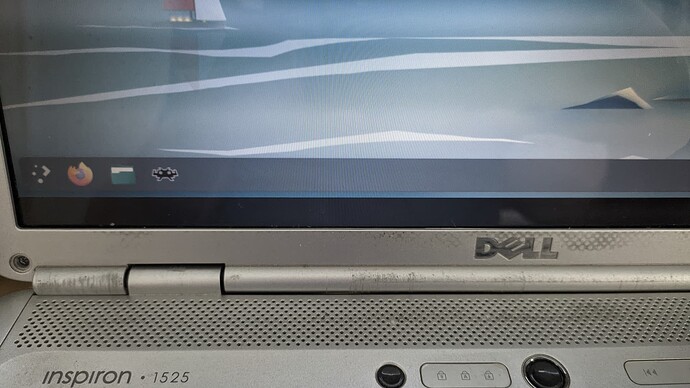After removing secondary screen from hdmi, kde is now displaying black bars on top and bottom.
The problem happens after I login on a wayland session, if I log into xorg then it display correctly.
Inxi output
System:
Kernel: 6.6.40-1-MANJARO arch: x86_64 bits: 64 compiler: gcc v: 14.1.1
Desktop: KDE Plasma v: 6.0.5 Distro: Manjaro base: Arch Linux
Machine:
Type: Portable System: Dell product: Inspiron 1525 v: N/A
serial: <superuser required>
Mobo: Dell model: N/A serial: <superuser required> BIOS: Dell v: A17
date: 10/27/2009
Battery:
ID-1: BAT0 charge: 5.6 Wh (100.0%) condition: 5.6/48.8 Wh (11.5%)
volts: 12.3 min: 11.1 model: DELL 00 status: full
CPU:
Info: dual core model: Intel Core2 Duo T6400 bits: 64 type: MCP arch: Penryn
rev: A cache: L1: 128 KiB L2: 2 MiB
Speed (MHz): avg: 1197 min/max: 1200/2000 cores: 1: 1197 2: 1197
bogomips: 7982
Flags: ht lm nx pae sse sse2 sse3 sse4_1 ssse3
Graphics:
Device-1: Intel Mobile GM965/GL960 Integrated Graphics
vendor: Dell Inspiron 1525 driver: i915 v: kernel arch: Gen-4
bus-ID: 00:02.0
Display: wayland server: X.org v: 1.21.1.13 with: Xwayland v: 24.1.1
compositor: kwin_wayland driver: X: loaded: modesetting dri: crocus
gpu: i915 resolution: 1280x720
API: EGL v: 1.5 drivers: crocus,swrast platforms:
active: wayland,x11,surfaceless,device inactive: gbm
API: OpenGL v: 4.5 compat-v: 2.1 vendor: intel mesa v: 24.1.3-manjaro1.1
glx-v: 1.4 direct-render: yes renderer: Mesa Intel 965GM (CL)
API: Vulkan Message: No Vulkan data available.
Audio:
Device-1: Intel 82801H HD Audio vendor: Dell Inspiron 1525
driver: snd_hda_intel v: kernel bus-ID: 00:1b.0
API: ALSA v: k6.6.40-1-MANJARO status: kernel-api
Server-1: PipeWire v: 1.2.1 status: active
Network:
Device-1: Marvell 88E8040 PCI-E Fast Ethernet vendor: Dell Inspiron 1525
driver: sky2 v: 1.30 port: de00 bus-ID: 09:00.0
IF: enp9s0 state: up speed: 100 Mbps duplex: full mac: <filter>
Device-2: Broadcom BCM4321 802.11a/b/g/n vendor: Dell Wireless 1500 Draft
802.11n WLAN Mini-card driver: wl v: kernel bus-ID: 0b:00.0
IF: wlp11s0 state: dormant mac: <filter>
Drives:
Local Storage: total: 111.79 GiB used: 72.14 GiB (64.5%)
ID-1: /dev/sda vendor: Kingston model: SA400S37120G size: 111.79 GiB
Partition:
ID-1: / size: 101.21 GiB used: 72.14 GiB (71.3%) fs: ext4 dev: /dev/sda1
Swap:
ID-1: swap-1 type: partition size: 8.4 GiB used: 0 KiB (0.0%) dev: /dev/sda2
Sensors:
System Temperatures: cpu: 52.0 C mobo: N/A
Fan Speeds (rpm): cpu: 0 fan-2: 0 fan-3: 0
Info:
Memory: total: 4 GiB available: 3.82 GiB used: 1.26 GiB (32.9%)
Processes: 158 Uptime: 37m Init: systemd
Packages: 1386 Compilers: clang: 18.1.8 gcc: 14.1.1 Shell: Zsh v: 5.9
inxi: 3.3.35
